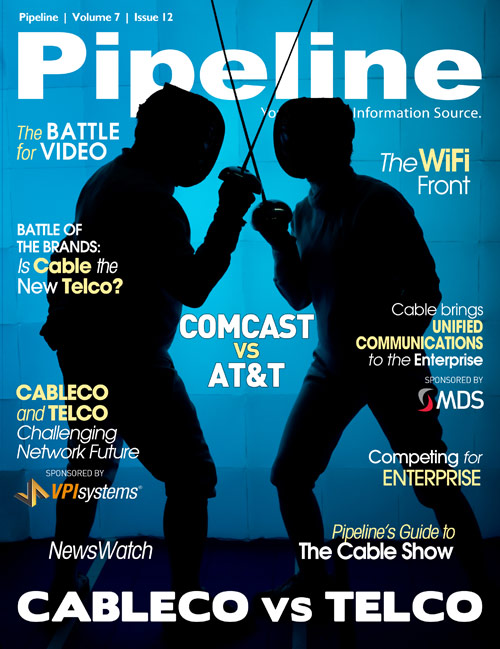Is CableCo the New Telco?
By: Chun-Ling Woon

"Cable versus Telco" is an interesting topic, but it begs the question: is anyone really winning? For far too long, Telcos had the luxury of being only game in town. The introduction of cable-broadband was a bit of a threat, but with their DSL offerings, Telcos seemed to be able to all but keep pace. But, let's face facts: They took it on the chin (hard) with the advent of VoIP. Telco's only saving grace has been their explosive mobile business which has kept them swinging in the ring like a doped-up boxer on steroids.
But, it appears that the competitive nature of once fierce competitors has all but fizzled out. Like prize fighters in the final round, it seems like each slow punch is now resting gingerly on the shoulder of the other. Telco's attempt at IPTV was meager at best. Cable's attempt to throttle and charge for tiered-broadband and interactive advertising has been met with gravitating customer resistance and lack of adoption. At the end of the day, despite both being war-torn, embattled, and bloody - no winner emerges. The world now turns its attention to agile, new competitors. The up-and-comers. The ones of which they do not speak: Netflix, HULU, Skype, Vonage, and the legions more appear each day. It has become painfully obvious that Communications Service Providers (CSPs) need a new strategy.
Network-centricity does not work
So, why is everyone still talking about their networks? Networks are like armpits: everyone has them and they all stink. What's so interesting about your network? Does it stink slightly less than the other guy's? More importantly: do your customers care? Chances are they don't. Most customers don't know what 2.5G, 3G, or 4G is; and they certainly don't understand how any "G" is going to provide any positive impact on their lifestyle.
Fact is,fixed networks, like Telco's and Cable's infrastructure,are the best around when it comes to speed, reliability, and quality of service. You simply can't beat a point-to-point connection with a big fat pipe. Yet, customers continue to flock to mobile and OTT providers for voice services despite outages, dropped calls, and lower quality overall. "Can you hear me now?"
With very few if any exceptions, Cable TV and video services are the almost certainly the best, offering reliable HD, on-demand, and even multi-device access. Yet even the largest cable operators are losing video subscribers in droves to low-to-no-cost providers like HULU and Netflix - who offer almost as much, for much less - despite diminished quality and reliability. Even Satellite TV providers have benefited from taking a share of the cable video market - despite the fact that even the smallest storm can bring their customers' Superbowl viewing experience to a screeching halt.
Connectivity, quality, and reliability by themselves don't work. Why, you ask? Because is the perfect formula for being a utility. And, by "utility," I mean a "commodity." A dirty, nationalized, regulated, void-of-competition, price-fixed commodity. No one will proudly don your logo if you are a commodity. So how can you, Mr. Service Provider, survive? Well, looking at your chart, I'm sorry to say there's a good chance you won't. But, simply put, you need to change your ways.
Customer-centricity works
If we look at the migration-pattern of customers over the last 20 years, we can learn a few, pivotal things: 1) customers want value more than quality, 2) customers want what's cool, and 3) Customers long to belong.
After the deregulation of Telco and advent of cellular and VoIP, decades-old, loyal customers were willing to drop dear ol' Ma' Bell like a hot rock to adopt unproven services and providers who offered lower quality of service. Even today companies like Comcast to Vonage are still benefiting by differentiating themselves from monolithic "big ol' telephone company." How about wireless services in general? Over the last 20 years, customers have been pleased to continue to shell-out hundreds of dollars each month for wireless services. Today, they would rather cut their reliable home-line so that they can keep their unreliable mobile-line.
I can't think of any single service provider that benefited more from any one event than AT&T with the introduction of the iPhone. There's probably a devices-drive-demand story in here somewhere, but customers actually paid their incumbent provider to churn. Read: customers paid to churn. Was it because AT&T's networks was better, more reliable, offered better quality of service or better customer care? Simply put, no. It was because the iPhone was cool.
Is it the device? Is the iPod/Phone/Pad really that great? Probably not. But try to telling that to someone who owns one you might have a fist-fight on your hands. The simple truth is that owning an i-anything is actually better than the thing itself. Why, you ask? Because customers want to feel privileged. They want to be a part of a unique and distinguished group - become their own celebrity - to be prestigious; to be cool.
So, now what?




